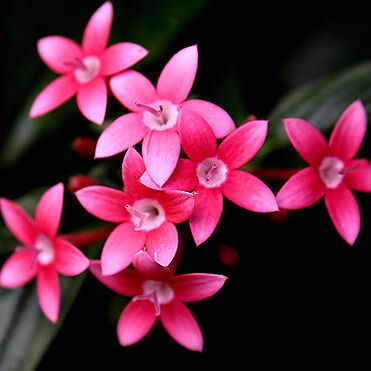Perennial herbs or subshrubs, unarmed. Raphides present. Leaves opposite or whorled, without domatia; stipules persistent, interpetiolar and sometimes fused to petioles, triangular to truncate, multifid or setaceous, with segments often gland-tipped. Inflorescences terminal, cymose, paniculate, or corymbiform, several to many flowered, subsessile to pedunculate, bracteate. Flowers subsessile, bisexual, distylous [or rarely tristylous]. Calyx limb deeply (4 or)5-lobed; lobes sometimes slightly to strongly unequal on an individual flower [sometimes with calycophylls]. Corolla white, pink, red, purple, or yellow, salverform to narrowly tubular with tube prolonged and usually expanded at throat, inside villous in throat; lobes (4 or)5(or 6), valvate in bud. Stamens (4 or)5(or 6), inserted in corolla just below throat, included in long-styled, mid-styled, and homostylous forms or exserted in short-styled form; filaments short to well developed; anthers dorsifixed. Ovary 2-celled, ovules numerous in each cell on axile placentas; stigmas 2, linear, included in short-styled and mid-styled forms or exserted in long-styled and monomorphic forms. Fruit capsular, subglobose to ovoid or obovoid with apex often elongated into conical beak, membranous or leathery, loculicidally dehiscent through apical portion, with calyx limb persistent; seeds numerous, small, angled to subglobose.
In monomorphic flowers stamens enclosed in an abrupt apical dilation of the tube and style exserted; in dimorphic flowers the tube is gradually dilated at the apex in short-styled flowers and abruptly dilated in long-styled flowers; in rare cases, trimorphism is shown and the third form has both stamens and style included in the tube.
Flowers small to very large, hermaphrodite, mono-, di-or tri-morphic, mostly in much-branched terminal complicated cymose inflorescences, the individual branches often becoming spicate in fruit.
Calyx tube ovoid or globose, sometimes with a free annular part at the top; lobes usually 5, either equal or unequal, 1–3 being larger than the others or sometimes foliaceous.
Capsule obtriangular or ovoid, ribbed, beaked, opening at the apex, the beak splitting into 4 valves; capsule sometimes separating into 2 cocci.
Corolla tube shortly cylindrical to narrowly tubular, 2–40 times as long as wide, hairy in the throat; lobes ovate or oblong.
Mostly perennial (rarely biennial) herbs or shrubs, with erect or straggling stems from a fibrous or woody rootstock.
Leaves paired or in whorls of 3–5; stipules divided into 2-many filiform colleter-tipped segments.
Ovary bilocular, with numerous ovules in each attached to placentas affixed to the septum.
Seeds minute, brownish, irregularly globose or tetrahedral, with reticulate testa.
Rhaphides are plentiful in most of the tissues.

